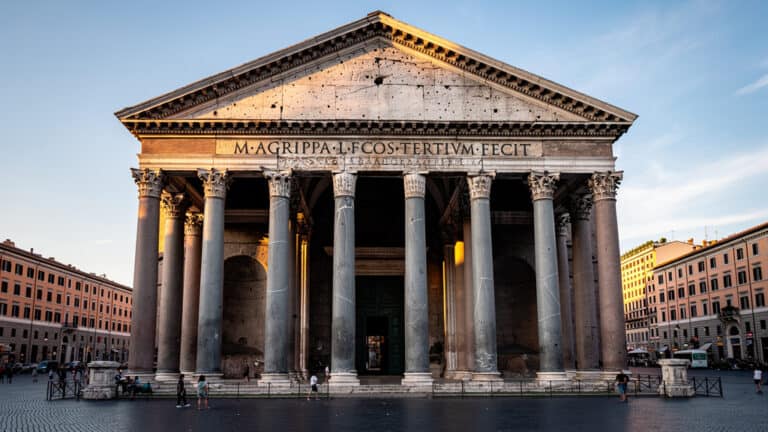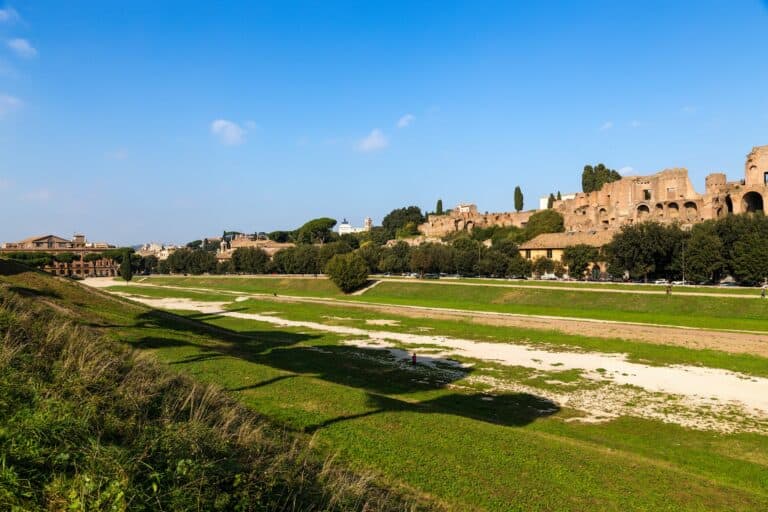Located on the southern section of the Aurelian Walls, Porta San Sebastiano is the largest and one of the best-preserved of Rome’s ancient gates. Originally known as Porta Appia due to its position on the historic Appian Way, the gate was later named for Saint Sebastian, the patron saint of soldiers, whose catacombs lie along the same route.
Built in the 3rd century A.D. by Emperor Aurelian, Porta San Sebastiano was designed to defend Rome against invasions. Over the centuries, it has seen modifications and restorations, including fortifications added in the 5th century by Emperor Honorius. The gate’s towering walls, ancient arches, and robust defensive design make it a striking relic of Rome’s imperial era.
Commissioned by Pope Pius IV in the mid-16th century, Porta Pia is one of Rome’s later gates, and it stands out as a masterpiece designed by Michelangelo. Built as part of the Aurelian Walls, Porta Pia served both practical and symbolic purposes, acting as a defense mechanism and a statement of papal authority.
Originally conceived as a response to the need for a new entrance into the city from the northeast, Porta Pia is one of Michelangelo’s last works, and its design reflects his genius. With its Renaissance style, it showcases a powerful blend of military functionality and artistic expression. While the exterior is fortified, its details are elegantly crafted, with niches, columns, and an imposing central archway.
Highlights of Porta Pia
- Architectural Heritage: As one of Michelangelo’s final projects, the gate exemplifies Renaissance architectural mastery and innovation.
- Key Historical Event: Porta Pia gained modern historical significance during the Breccia di Porta Pia, when Italian forces breached the wall here in 1870, marking the fall of the Papal States and the unification of Italy.
- Symbol of Roman Strength and Resilience: Porta Pia reflects not only Rome’s military strength but also the resilience of the city through political change.
Why Visit Porta San Sebastiano with ETuktoursrome?
At ETuktoursrome, we guide you through the impressive structure of Porta San Sebastiano, its history, and its connection to the Appian Way. Our guides reveal the strategic significance of this ancient gate, its transformation through the centuries, and the stories of those who defended it. Visitors can even walk along sections of the Aurelian Walls, immersing themselves in the history of Roman defense and exploration.
Fun Facts About Porta Pia and Porta San Sebastiano
- Michelangelo’s Touch at Porta Pia: Porta Pia is one of the few Michelangelo-designed gates in the world, a rare example of his influence on fortification architecture.
- Porta Pia’s Role in Italian Unification: The breach at Porta Pia in 1870 symbolizes the end of the Papal States and the beginning of Rome as Italy’s capital.
- Largest Ancient Gate: Porta San Sebastiano is the largest and most well-preserved gate on the Aurelian Walls, allowing visitors to experience a key part of Rome’s ancient fortifications.
- Museum Inside the Walls: Porta San Sebastiano houses a museum dedicated to the Aurelian Walls, offering historical artifacts and insights into Rome’s defenses.
- The Appian Way Connection: Porta San Sebastiano served as the main entrance to the Appian Way, one of the most strategically important and historically rich roads of ancient Rome.
Experience Porta Pia and Porta San Sebastiano with ETuktoursrome
These historic gates are more than just entry points—they’re time portals to Rome’s dynamic history. With ETuktoursrome, you’ll gain exclusive insights into the architecture, history, and cultural importance of both Porta Pia and Porta San Sebastiano. Our guides bring each site’s story to life, from Michelangelo’s artistry to the daring acts of soldiers and the strategic minds of emperors.
Book your tour with us and immerse yourself in the legacy of Rome’s ancient walls, exploring these gates and their hidden stories that have shaped the Eternal City across millennia!








